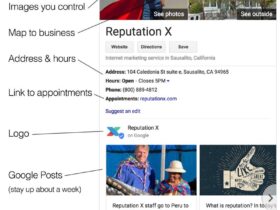Social media algorithms shape user experiences on platforms like Facebook, Instagram, and Twitter. They curate content based on user interests by analyzing behavior and ranking signals such as engagement and relevance. While these algorithms personalize feeds, they can also create filter bubbles that limit diverse perspectives. To enhance their experience, users should diversify content engagement, understand how algorithms work to mitigate biases and enjoy a more balanced social media journey.
What is an Algorithm?
An algorithm is a systematic, step-by-step procedure or formula for solving a problem. It plays a crucial role in various technologies, including social media platforms. Algorithms determine how content is filtered and ranked for users, influencing user interactions and engagement levels across multiple platforms, such as Facebook, Instagram, TikTok, and YouTube.
They utilize data relevance and user behavior to optimize content visibility and engagement strategies, making them essential for understanding user preferences and personalization. The role of AI in this process cannot be overlooked, as it significantly enhances algorithmic design and content curation.
Definition and Purpose of Social Media Algorithms
Social media algorithms are intricate rules and calculations that social media platforms use to prioritize and organize content in a user’s feed. These algorithms are designed to create a personalized and engaging experience by serving relevant content that aligns with each user’s unique interests and preferences. By analyzing user behavior and interactions, social media algorithms ensure that users see the most pertinent and engaging posts, enhancing their overall experience on the platform.
Brief History of Social Media Algorithms
The journey of social media algorithms began in the early 2000s when platforms like Facebook and Twitter introduced basic ranking systems to manage the growing volume of content. Initially, these algorithms were relatively simple, focusing on chronological order and basic engagement metrics. However, as user bases expanded and technology advanced, these algorithms evolved significantly.
Today, they incorporate sophisticated machine learning and artificial intelligence techniques to understand user behavior and preferences better. This evolution has transformed how content is delivered, making social media a more dynamic and personalized space.
How Do Algorithms Work on Social Media Platforms?
Social media algorithms shape user experiences on platforms like Facebook, Instagram, TikTok, YouTube, and LinkedIn. They analyze user behavior and engagement to personalize content and determine what appears in feeds. Utilizing various ranking signals such as engagement, relevance, and user preferences, these algorithms optimize content visibility and foster personalized user interactions. They collect and process data to tailor feeds, enhancing engagement but potentially creating filter bubbles and echo chambers that limit diverse perspectives.
As AI and data analytics advance, future algorithms will continue to evolve, refining personalized content delivery and engagement strategies to meet the needs of social media users. Understanding these algorithms and diversifying platform use can help users mitigate algorithmic biases and enhance their social media experiences.
Relevancy and Value of Content
Relevance and value are paramount in social media. Social media algorithms meticulously assess the relevance of content by analyzing various signals, such as user behavior, engagement levels, and specific keywords. High-quality content that resonates with users is more likely to be prioritized in their feeds, while content deemed irrelevant or low quality may be demoted or hidden. For businesses and individuals, creating content that adds value and engages users is crucial for increasing online visibility and fostering meaningful interactions.
Signals and Important Factors Social Algorithms Consider
Social media algorithms rely on many signals and factors to rank content effectively. These include:
- User Behavior: Algorithms scrutinize user interactions, such as likes, comments, shares, and clicks, to gauge what content is most engaging and relevant.
- Engagement: High levels of engagement, such as comments and shares, can significantly boost a post’s visibility.
- Keywords: Using relevant keywords and hashtags helps algorithms understand the content and context of a post.
- User Preferences: Algorithms consider user preferences, including interests and demographics, to deliver personalized content.
- Timing: The timing of a post can affect its visibility, with algorithms often favoring recent and timely content.
- Content Quality: Feeds are more likely to prioritize high-quality informative, entertaining, or engaging content.
By understanding these signals and factors, businesses and individuals can optimize their content and social media marketing strategies to enhance their online presence and engagement.
What Factors Influence Social Media Algorithms?
User Engagement
User engagement is a pivotal element that social media algorithms track to prioritize and display content to audiences. High levels of interactions, such as likes, shares, and comments, indicate the relevance and quality of content, influencing its visibility and reach. This engagement reflects how well the message resonates with its audience, fueling a cycle of interaction and visibility.
Brands and content creators must implement effective strategies to amplify their online presence, such as using interactive polls to spark conversation, hosting live Q&A sessions for direct interaction, creating eye-catching visuals to capture attention quickly, and tailoring content to specific demographics to enhance engagement.
These techniques improve user interactions and increase the likelihood of sharing content across platforms, driving organic traffic and visibility.
Relevancy of Content
Content relevancy is crucial for social media algorithms as it significantly influences content ranking and display to users. By evaluating user interactions such as likes, shares, comments, and viewing duration, algorithms determine which content resonates most with individuals, enhancing content discovery. Engagement levels are a key indicator, with highly engaged users likely to receive similar content.
Additionally, algorithms consider the recency and frequency of interactions to curate a dynamic, personalized experience. A deep understanding of user behavior affects content positioning and is vital in creating a more satisfying user experience that encourages exploration and retention.
Timeliness of Posts
The timeliness of posts is crucial for social media algorithms, as they prioritize fresh content to enhance user interactions and ensure users see the most current material. Recent algorithm changes favor up-to-date posts, influencing how users engage with platforms and emphasizing the importance of timely content. This prioritization helps trending topics and breaking news reach audiences, encouraging participation.
User interactions with timely content, like likes and shares, boost visibility and contribute to broader conversations. Engagement grows faster within the first hour of publication, and timely content often sparks discussions related to current events, significantly influenced by AI and social media platform algorithms.
In this dynamic digital landscape, content creators must adapt strategies to align with algorithmic preferences while delivering value to their audience.
User Preferences and Interests
User preferences and interests are central to social media algorithms, enhancing content personalization by analyzing user behavior to determine engagement likelihood. In the digital age, where information overload is common, algorithms sift through data to prioritize content that aligns with past interactions, preferences, and mood shifts, optimizing engagement chances.
Algorithm and behavior analysis are crucial, allowing platforms to understand user patterns and refine their approach. For example, time spent on posts signals user interest, while likes, shares, and comments highlight evolving interests, enhancing user satisfaction and platform efficiency in delivering relevant content.
How Do Social Media Algorithms Affect Users?
Social media algorithms significantly influence user experiences by creating filter bubbles and echo chambers, which can limit exposure to diverse content and reinforce existing beliefs. These algorithms curate content based on user behavior, often leading to manipulation of user interactions and hindering diverse content discovery across platforms like Facebook, Instagram, and Twitter.
Filter bubbles isolate users by showcasing content aligning with their beliefs, while echo chambers amplify similar viewpoints, distorting broader perspectives. This can lead to societal divisions and reduced critical thinking.
To combat these effects, users should actively seek varied viewpoints and diversify their information sources, enhancing their social media experience and mitigating algorithmic biases.
How Can Users Adapt to Social Media Algorithms?
Users can adapt to social media algorithms by understanding how these systems function, enabling informed choices about content consumption and engagement strategies. By diversifying their social media use and engaging with various content types, users can enhance their experience and reduce algorithmic biases. Understanding algorithms allow users to optimize posts for maximum reach, identify resonant trends, and use analytical tools to measure strategy efficacy.
Diversifying social media interactions across platforms like TikTok, YouTube, and LinkedIn exposes users to broader perspectives, mitigating filter bubbles. Engaging with different content types, such as video and live streams, can improve interactions and influence algorithmic content prioritization, enhancing user experience and fostering vibrant communities.
The Future of Social Media Algorithms
Advancements in AI and data analytics will shape the future of social media algorithms, leading to refined engagement strategies and personalized content delivery on platforms like Twitter and LinkedIn. As user behavior changes, algorithms, including those of platforms like YouTube, will adapt to meet the needs of online audiences, ensuring that relevant content stays prominent in user interactions.















